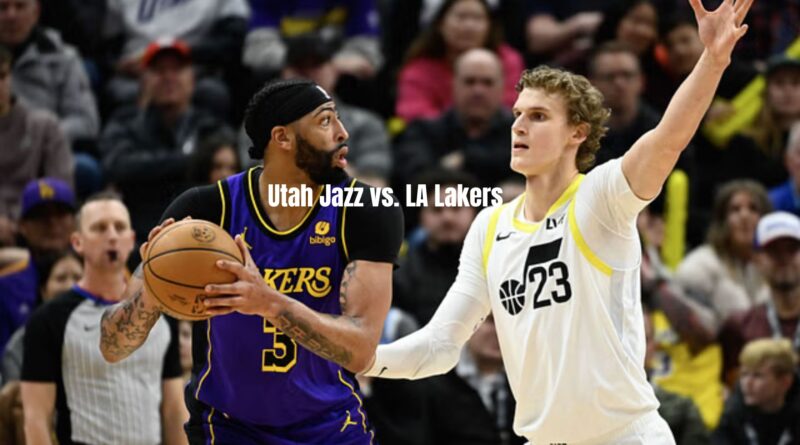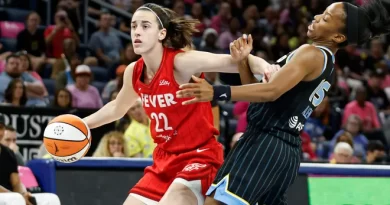Statistics Released: Utah Jazz vs. LA Lakers
Statistics released: Utah Jazz vs. LA Lakers
Every possession holds significance, and every player’s contribution is critical in the competitive environment of the NBA. In the recent matchup between the Utah Jazz and the Los Angeles Lakers, the box score provided only a partial picture of the game’s complexity.
This detailed analysis moves beyond simply identifying the leading scorers. It delves into efficiency metrics, defensive impact, and momentum-shifting sequences that ultimately determined the outcome.
Opening Narrative: Beyond a Routine Game
The contest between the Lakers and the Jazz proved to be more than a standard regular-season encounter. The anticipation centered on the Jazz’s surprising competitiveness amidst their rebuilding phase and LeBron James’ opportunity to reach another career milestone.
While the youthful Jazz showcased their depth and emerging talent, the experienced Lakers leaned on their seasoned core, resulting in a compelling clash of styles.
Although the final scoreline of 117–103 in favor of the Lakers may suggest a one-sided affair, the game was highly competitive, featuring multiple lead changes and momentum swings that maintained suspense into the fourth quarter.
“This game was about trusting the process and making adjustments,” Lakers Head Coach Darvin Ham stated. “We eventually found our rhythm, according to the statistics, but Utah challenged us on every possession.”
A critical factor proved to be shooting efficiency. The Jazz took more field goal attempts (96 to the Lakers’ 89), but the Lakers shot 48.3% from the field, significantly outperforming Utah in conversion rate.
LeBron James vs. Lauri Markkanen: The Battle of Star Power
A key matchup unfolded between veteran superstar LeBron James and emerging forward Lauri Markkanen. Both players performed admirably, yet their impact varied over the course of the game.
LeBron’s influence peaked in the third quarter, where he guided the Lakers to a 12–2 run and their first double-digit lead, scoring 14 points and delivering 5 assists. His tactical awareness and ability to exploit mismatches were on full display.
Conversely, Markkanen’s impact was most pronounced in the first half, when he tallied 17 of his 25 points. He kept Utah competitive with timely perimeter shooting and strong rebounding. However, defensive adjustments by the Lakers, particularly involving Anthony Davis, significantly limited his effectiveness in the latter stages.
Scoring Breakdown:
LeBron James
- Q1: 6 points (3-5 FG)
- Q2: 5 points (2-3 FG)
- Q3: 14 points (5-6 FG)
- Q4: 3 points (0-3 FG)
Lauri Markkanen
- Q1: 10 points (4-7 FG)
- Q2: 7 points (3-5 FG)
- Q3: 4 points (1-4 FG)
- Q4: 4 points (1-3 FG)
LeBron further exhibited his versatility in clutch scenarios, registering three assists in the final five minutes without attempting a field goal, thereby creating high-value scoring opportunities for teammates.
Interior Matchup: Jazz Defence vs. Lakers Frontcourt
The interior duel between Anthony Davis and Walker Kessler proved decisive. Kessler provided traditional rim protection, but Davis’ dynamic offensive and defensive skill set prevailed.
Davis concluded with 23 points, 15 rebounds, and 4 blocks, shooting 56.3% from the field. Notably, he produced these numbers despite being benched for much of the fourth quarter with the game securely in hand.
Although Kessler showed flashes of defensive prowess with three blocks in 21 minutes, foul trouble limited his effectiveness.
Scoring Efficiency in the Paint:
- Lakers: 26/38 (68.4%)
- Jazz: 25/48 (52.1%)
Davis altered numerous shots beyond his block total. Jazz players converted only 8 of 19 field goal attempts when Davis was the primary defender, further highlighting his defensive influence.
Guard Play: Ball Movement and Scoring Impact
Distinct differences emerged in backcourt play. Utah relied on the explosiveness of Collin Sexton and Jordan Clarkson, while the Lakers benefitted from the composed orchestration of D’Angelo Russell.
Russell finished with 18 points, 9 assists, and only 2 turnovers, resulting in a 4.5 assist-to-turnover ratio. Alongside him, Austin Reaves contributed 14 points, 6 assists, and two steals, providing steady defensive pressure on the perimeter.
Utah’s backcourt struggled with turnovers and defensive execution. Clarkson led Jazz guards with 19 points but committed four turnovers and registered a -12 plus/minus.
Three-Point Shooting (Guards):
- Lakers: 6-of-14 (42.9%)
- Jazz: 4-of-13 (30.8%)
“Our guards set the tone defensively,” Davis commented. “When D’Lo and Austin apply that level of pressure while making sound decisions, we become very difficult to beat.”
Bench Contributions: Revealing Depth Disparities
Although starters established the foundation, bench performance significantly influenced the result.
The Lakers’ reserves outscored Utah’s bench 34–28, with Rui Hachimura (12 points, 5 rebounds) and Lonnie Walker IV (10 points) making critical contributions. Their strong second-quarter showing preserved the lead during James’ absence.
In contrast, despite a solid showing from Talen Horton-Tucker (11 points), Utah’s bench collectively posted a -31 plus/minus, indicating defensive vulnerability.
The game-turning 14–4 run early in the fourth quarter, while Utah’s starters rested, underscored this discrepancy.
Key Momentum Shifts
Several pivotal sequences influenced the game’s trajectory:
Lakers’ Third-Quarter Run (16–6):
Sparked by LeBron’s playmaking and Davis’ dominance inside. The team forced four turnovers in under five minutes while converting 7-of-9 field goals.
Jazz Fourth-Quarter Rally Halted:
Utah briefly narrowed the deficit to 8, but the Lakers responded with four made field goals in five possessions, extending the lead to 19.
Russell’s Back-to-Back Three-Pointers:
Occurring in a critical third-quarter stretch, Russell’s shots instantly reinstated a double-digit advantage, deflating Utah’s momentum.
Advanced Metrics: What the Data Reveals
Analytics uncovered deeper insights into individual and team contributions:
- The Lakers’ closing lineup (James, Davis, Russell, Reaves, Hachimura) recorded a +21.4 net rating over 12 minutes.
- Utah’s primary lineup (Sexton, Clarkson, Markkanen, Olynyk, Kessler) played only 8 minutes together due to foul trouble, posting a +3.8 net rating.
Efficiency Metrics:
- Lakers’ pick-and-rolls featuring James and Davis produced 1.19 points per possession.
- Utah allowed 1.08 points per possession—above their season average of 0.97.
- Half-court efficiency: Lakers – 1.04 PPP, Jazz – 0.88 PPP.
Coaching Tactics and Rotational Decisions
The strategic contest between Darvin Ham and Will Hardy manifested in several key areas:
Timeout Effectiveness:
Lakers scored 22 points post-timeouts compared to Utah’s 14. Jazz averaged just 0.78 PPP following timeouts.
Player Management:
Ham reduced minutes for James (34) and Davis (32) below their seasonal averages, keeping them fresh. Conversely, Markkanen (38 minutes) exceeded his average, reflecting Utah’s reliance on starters.
Defensive Adjustments:
The decision to assign Davis to Markkanen in the second half proved critical. Markkanen went from 7-of-10 shooting in the first half to 2-of-9 in the second.
The Lakers improved their defensive rating from 112.7 (1st half) to 102.4 (2nd half), validating the effectiveness of these adjustments.
Frequently Asked Questions
Which figure better depicts LeBron’s importance beyond scoring?
LeBron’s +18 plus/minus and 12 passes for 28 points show his influence. He improved Lakers field goal accuracy by 7%.
benchmark figures showing depth difference?
The Lakers’ bench shot 51.9% compared to Utah’s 37.9%, and their plus/minus was +13 to -31.
Which player lost the most due to defensive adjustments?
In the first half, Markkanen scored 17 points on 70% shooting. After Davis guarded him, he scored 8 points on 22% shooting in the second half.
Utah lost despite having more shots.
Utah had 96 shots against the Lakers’ 89. Utah had 49.3% true shooting, while the Lakers had 58.7%. Only 28.1% of Jazz three-point attempts were made.
The most analytically underestimated player?
Austin Reaves hit 75%, scored 14 points, and had 6 assists for a game-high +19 plus/minus.
Which trend broke the season’s pattern?
Lakers rarely score in transition, but they beat Utah 23–14 in fast-break points thanks to 18 Utah turnovers.
That showed the teams’ experience gaps.
The Lakers limited Utah to 22.2%, made three mistakes, and shot 71.4% in the final five minutes. In this quarter, LeBron and Davis made four shots.
Conclusion: What the Numbers Tell Us
This comprehensive statistical review reveals the key elements that shaped the outcome:
LeBron James’ All-Around Influence:
A 58.8% shooting percentage and a 4:1 assist-to-turnover ratio, complemented by a game-best +18 plus/minus, underscored his broad impact.
Anthony Davis’ Defensive Impact:
Utah’s field goal percentage dropped by nearly 7% when Davis was on the court. His 15 rebounds and 4 blocks provided both scoring and possession advantages.
Backcourt Efficiency:
The Lakers’ guards committed only 4 turnovers in 81 combined minutes, compared to 11 from Utah’s guards, directly contributing to 16 Lakers points.
Bench Effectiveness:
Despite similar scoring, the Lakers’ bench shot 51.9% compared to Utah’s 37.9% and maintained a +13 plus/minus advantage.
Three-Point Differential:
- The Lakers’ 41.9% from beyond the arc (13-of-31) contrasted sharply with Utah’s 28.1% (9-of-32), accounting for nearly the entire margin of victory.
- Key turning points included Davis’ defensive reassignment at 9:42 in the third quarter, Russell’s back-to-back threes at 2:15 in the same period, and a crucial 10–2 run led by Walker IV early in the fourth.
- While the Lakers demonstrated improved defensive cohesion—limiting Utah to 103 points, below their season average—Utah’s 28 assists on 40 field goals (70%) illustrated their continued commitment to ball movement.
- Ultimately, this game underscored the notion that victories at the professional level are often secured through statistical efficiency rather than volume. The Lakers’ superior shooting percentages, strategic defensive assignments, and productive rotations proved decisive.
LeBron James and Anthony Davis continue to anchor a Lakers team with postseason aspirations, while Lauri Markkanen and Utah’s promising core provide a glimpse into a bright future.




